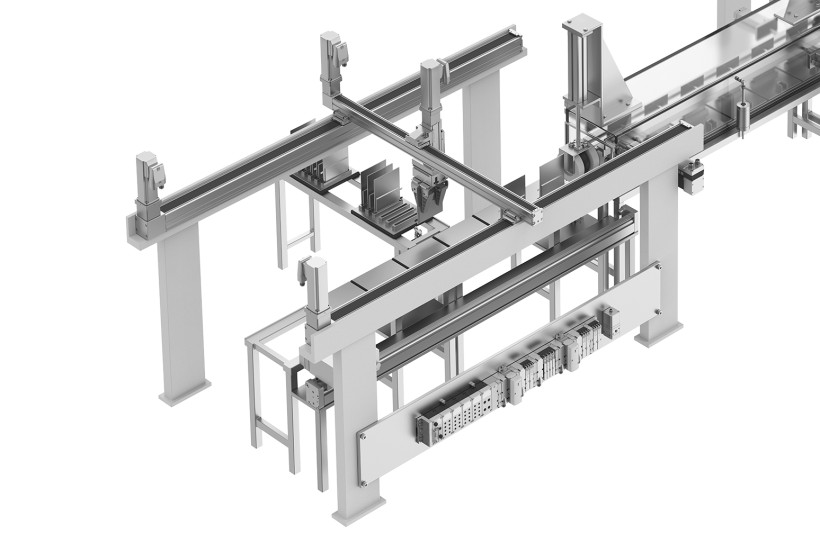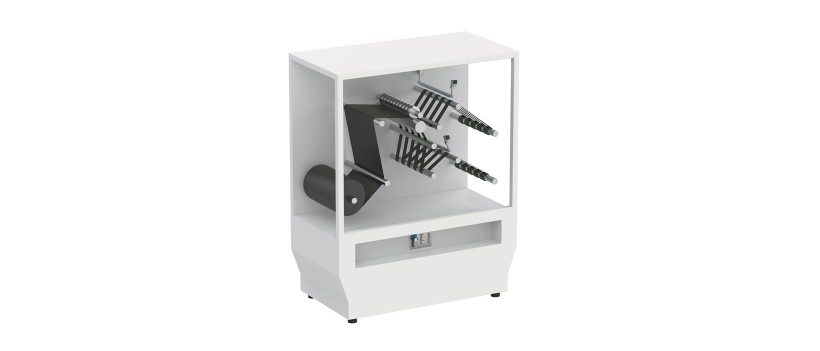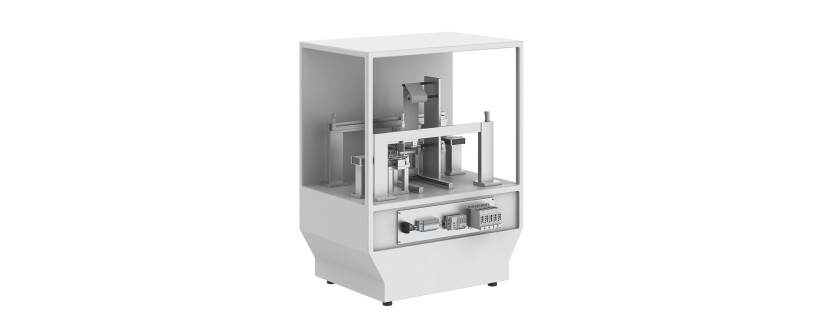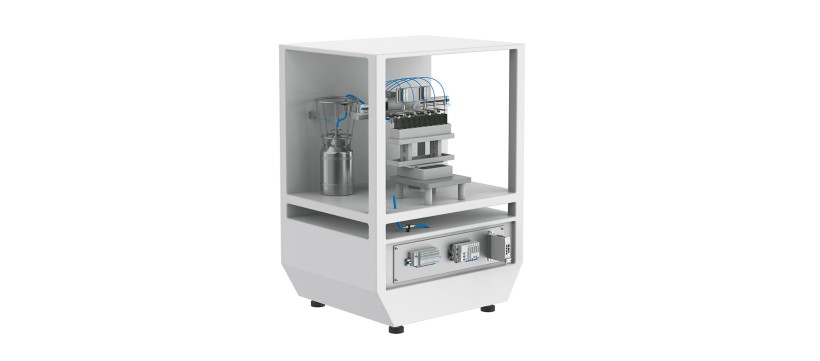Speed and precision for your battery manufacturing
From cells and module production to inserting the battery systems, Festo has the right automation solutions for the entire battery manufacturing process, be it pneumatic, electric or hybrid. In battery manufacturing, high throughput and repeat accuracy are just as important as cost-effective solutions. This applies to many different process steps, from conveying, supplying and controlling aggressive media to precise parts handling and force-controlled pressing applications.
Festo product portfolio for battery production
Producing batteries is an extremely sensitive process. Each phase of the production environment, whether processing, transport or quality inspection, should therefore be clean.
Find out how to produce safe batteries with non-ferrous metal-free automation components in our catalogue 'Products for battery production'.
Automation solutions for your applications
Precisely controlled degassing and sealing
During the formation process, gas builds up in the battery cell. This gas must be removed. This is done by piercing the battery cell using a hollow lance and evacuating the gas until electrolyte is being drawn off too. The system then switches over and pumps the drawn off electrolyte back into the battery cell, and the rest of the gas is removed. Handling systems from Festo help with loading the battery cells onto the workpiece carriers for insertion into the process camera and then unloading them again afterwards.
Suitable products for degassing and sealing the battery cell
Augmented reality animation (only available in English)

Safe cutting and clamping with WebCatcher
The purpose of cutting is to divide a wide strip of electrode foil into several narrower strips. This cutting process can be done thermally using laser cutting or carried out mechanically using a rolling cutter. To extend the cutter’s service life, a cooling liquid is sprayed directly onto the blade during this process. The liquid must be dispensed in a controlled way and in very small quantities. The dispense head from Festo is perfect for this task. If the machine stops during the cutting process, the electrode strips are secured using what are known as WebCatchers. Fast-switching valves and cylinders are used to ensure a fast response time and speed.
Suitable products for cutting and clamping electrode strips

High-speed stacking
In the production of pouch cells a stacking process is used. During the stacking process, the electrode sheets are stacked in a repeating cycle of anode, separator, cathode, separator, etc. Festo offers complete electric handling systems for this particular process step, consisting of axis kinematics, motors and servo drives. All the components are perfectly matched. Very high speeds are required for maximum output. These are achieved by fast-switching valves with switching frequencies of up to 500 Hz. The vacuum needed to pick up and transfer the electrode sheets is generated using vacuum generators.
Suitable products for stacking electrode sheets

Safe and precise filling with electrolyte
Once the cell stack or jelly roll has been inserted in the battery housing, the battery cell can be filled with electrolyte. The electrolyte is dispensed via the pinch valve. It is actuated using individual valves or valve terminals. Since electrolyte reacts with water and forms hydrofluoric acid, the ambient air must be very dry when filling the battery cells. To ensure this is the case, the air is continuously evacuated and removed from the machine cell. The vacuum required to do this is generated centrally via a vacuum pump. The process is regulated by a system of pinch valves, valve terminals and pressure sensors.
Suitable products for filling with electrolyte

Success story: future battery production
Electric vehicles are setting a trend. However, their success depends on high-performance and cost-effective batteries. In the UK, the pilot project AMPLiFII at WMG is laying the foundations of a new generation of traction batteries. The project includes innovative automation technology from Horizon Instruments with a Festo pick & place solution.
FAQs about products for battery cell manufacturing
What are the requirements for products used in manufacturing battery cells?
Manufacturing battery cells is a highly sensitive process with a wide range of requirements. Contaminants such as copper, zinc or electrically conductive or non-conductive particles can reduce the quality of the batteries or render them unusable.
Since there is no set legal standard, Festo assesses its product design according to established criteria and on the basis of detailed customer specifications. To ensure the safety of battery cell production, cleanroom products and products with restrictions in terms of non-ferrous metals such as copper and zinc are often needed.
The production environment also plays an important role in the manufacture of lithium-ion batteries. Products in cell production are often exposed to a dry-room environment with condensation points as low as –80°C.
How does Festo define the restrictions concerning non-ferrous metals (copper, zinc, nickel)?
Depending on the electrolyte and electrode material, copper, zinc and nickel may cause problems in the production of lithium-ion batteries. It is for this reason that Festo has defined criteria restricting the use of copper, zinc and nickel in its product development: metallic materials with copper, zinc or nickel as a main component are excluded from use. However, some alloys require the addition of these elements within the metal matrix.
Exceptions to material restrictions concerning copper, zinc and nickel:
- Nickel in ferrous metals
- Electroless nickel plating without a copper sub-layer
- Inert chemical compounds, such as oxides and sulphides
- Printed circuit boards, electric plugs, cables, wires and coils
Which products meet the restrictions defined by Festo for copper, zinc and nickel?
Many standard products from Festo already meet the restrictions defined by Festo for copper, zinc and nickel. These are marked in the "Automation solutions for battery production" brochure and in the overview in our Online Shop.
Products for battery cell manufacturing
There are special variants of products that are often needed for cell production but do not meet Festo-defined restrictions as standard products.
These special variants are marked with F1A in the ID code and can also be found in the brochure and product overview.
Which Festo products are suitable for dry-room environments?
A dry-room environment with a pressure condensation point of –50°C down to sometimes –80°C is typical for lithium-ion cell production. The dry-room environment inhibits the hydrophilic tendency of many electrolytes and prevents the risk of harmful hydrofluoric acid forming through reaction with humidity in the ambient air.
Standard products from Festo have proven their worth in dry-room applications such as battery manufacturing. Festo products can be used in environments with a condensation point of –80°C or even lower, since none of the approx. 60 different lubricants from Festo contains water as a component of the formulation.
As a result, none of these lubricants dries out when they come into contact with even very dry air. Moreover, no Festo lubricant requires moisture or liquid water to achieve or preserve its lubricating properties.
Which solutions does Festo provide for cleanrooms?
You can use Festo cylinders, valves, grippers and drives, all handling, vacuum and compressed air systems, sensors, filters, regulators and fittings from more than 80 product ranges in ISO class 7 cleanroom environments. Most are suitable for use in classes 6 and 5, and many can even be used in class 4 environments. We can also provide customised special solutions.
All our cleanroom products are classified into cleanroom classes according to ISO 14664. It’s best to check the exact requirements with our specialists, because particle emissions depend on the application in question. That’s the fastest way to find a workable solution.
Expertise to download
For electric vehicles, battery production is the critical factor. Be part of the move to unlock the full potential – with automation technology from Festo.
Brochures to download
The race for efficient systems is already well under way. Our observations indicate that efficient automation can considerably reduce the costs of manufacturing batteries.
Why not share with your colleagues what Festo can contribute in this area?